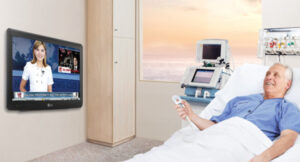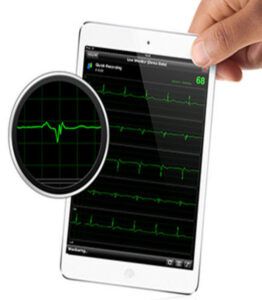Innovation in the tech world is quite an amazing phenomenon. We see hundreds of innovative ideas that are converted into life changing experiences not just for specific industries but also for us as individuals. Industrial sectors have undergone changes in their mode of operations thanks to technological advances and new markets being created. In this piece, we will be discussing how the health sector is being challenged and enhanced by innovative technology. As Smart Hospitals are becoming the new trend in the health sector at a rapid pace, let’s look at some of their key features:
Digitalization
 ‘Digitalization’ refers to anything undergoing a technological change. It is, however, important to note that ‘digital’ does not imply the entire hospital is to be operated and run by robots. The main aspect of technological innovation lies within the realm of patient experience. Digital patient experience will allow physicians to interact with patients in a more controlled and efficient way. One of the many tools healthcare professionals can use to create a sense of digitalization is Blockchain Technology. Blockchain allows to secure a patient’s digital record in a digitalized ledger, which will allow Smart Hospitals to exchange information with research organizations and other institutions.
‘Digitalization’ refers to anything undergoing a technological change. It is, however, important to note that ‘digital’ does not imply the entire hospital is to be operated and run by robots. The main aspect of technological innovation lies within the realm of patient experience. Digital patient experience will allow physicians to interact with patients in a more controlled and efficient way. One of the many tools healthcare professionals can use to create a sense of digitalization is Blockchain Technology. Blockchain allows to secure a patient’s digital record in a digitalized ledger, which will allow Smart Hospitals to exchange information with research organizations and other institutions.
The introduction of digital technology can change the experience of a patient, through a more convenient experience. As patients are not always comfortable in hospitals, innovative technology can give them a piece of mind, by allowing them to access their own medical charts, for example. Patients could also control and change the temperature of their room, for maximum comfort.
Facilities
 The integration of smart technologies has also allowed to enhanced some of the most basic facilities need. For example, the need for enhanced security thought maternity wards has always been a major concern. Smart technology allows all sections of a hospital to be virtually secured. By installing door alarms and secured locks hence, smart hospitals can increase the overall safety of a patient.
The integration of smart technologies has also allowed to enhanced some of the most basic facilities need. For example, the need for enhanced security thought maternity wards has always been a major concern. Smart technology allows all sections of a hospital to be virtually secured. By installing door alarms and secured locks hence, smart hospitals can increase the overall safety of a patient.
Some of the accommodations which are not as essential for a patient’s wellbeing, such as internet and TV, can also be enhanced through smart technology. A bedside terminal can be installed which allows a patient to have access to adjust the lighting in their rooms and bed lifts. It’s important to note that the main purpose of introducing the option of smart facilities is not limited to a patient’s experience: it also extends towards management & hospital administration.
Ease of Access
One of the benefits of technology being implemented in hospitals is cost reduction by connecting patients to their assigned specialists. We now have the technology for Smart devices to transmit data from scales, blood pressure cuffs, etc. directly into a patient’s medical record stored and accessed digitally. Everything is accumulated and categorized automatically and can be accessed easily using digital devices. Some apps and systems allow real time monitoring of vital signs of patients and, in the event of an emergency, the responding staff can immediately be notified. The team can then override the elevators while the patient’s bed will return to a flat position to allow for immediate resuscitation methods. As the team arrives, the alert will stop, and the patient’s medical record can be on display in the room for fast reference.
Handheld
 The scope of smart hospitals does not end there however, technology implementation at hospitals can also improve the patient-doctor relationships and increase the patient’s understanding of their medical state. By using handheld technologies such as iPads and smartphones, processes can be done much faster and in a more convenient way. If a doctor needs to explain a person’s ailment to the patient or their family, they can simply pull out an iPad and access a virtually unlimited amount of resources which can be linked to a patient’s electronic records and test results in seconds. Physicians can then access all of the information and even create a 3-d model to better explain the situation to their patients. Patients will have a greater understanding of how things work and can respond to their physicians in a more proactive way. As these technologies are being implemented on a small scale today, they have the potential to redefine the healthcare of tomorrow.
The scope of smart hospitals does not end there however, technology implementation at hospitals can also improve the patient-doctor relationships and increase the patient’s understanding of their medical state. By using handheld technologies such as iPads and smartphones, processes can be done much faster and in a more convenient way. If a doctor needs to explain a person’s ailment to the patient or their family, they can simply pull out an iPad and access a virtually unlimited amount of resources which can be linked to a patient’s electronic records and test results in seconds. Physicians can then access all of the information and even create a 3-d model to better explain the situation to their patients. Patients will have a greater understanding of how things work and can respond to their physicians in a more proactive way. As these technologies are being implemented on a small scale today, they have the potential to redefine the healthcare of tomorrow.
This technological implementation can surpass laptops in its practicality and allow caregivers to save up on a lot of time. Handled devices such as tablets can work anywhere inside the hospital, following staff at all times, who no longer have to go back to a stationary computer. This saves up many hours of precious time which can be a matter of life and death for a patient. This free time can then be spent with patients, reviewing records and dealing with paperwork. This can also reduce medication errors and other potentially harmful scenarios.
The potential of having hundreds of clinical references in the palm of your hand is priceless. You can easily access crucial facts on thousands of diseases, medications, drug interactions, and have access to thousands of images and videos which can make ease the tasks of all hospital employees. This also reduces the amount of time the patient as to wait while the doctor administers care: thanks to smartphones and tablets, processes are much faster and can be completed in just a few taps. In addition to this, you can also get the opinion of another doctor in just a few minutes. The possibilities and applications for this technology are growing every day, as hundreds of hospitals around the world already putting this technology into implementation.
Cost cutting
The implementation of smart technologies can reduce about 35 percent of costs, thanks to more efficient hospitalization rates, length of stay, professional services and outpatient procedures. Digitalization will allow for the patient to have access to medical care from outside the hospital, and can easily get a consultation on their smartphones, without having to come back in. Thanks to digital devices, administering medical care is more efficient and accurate as mentioned before. This therefore shortens the average patient’s length of stay, reducing costs even further.
Integration
As we know, it is easier to implement such ground-breaking technologies and concepts from scratch as you can mould other factors to fit the circumstances. Digital technology is exactly like that, and it will be easier to implement it in a new hospital. So what about retrofitting existing hospitals? How easy is it to integrated digital technologies with older existing processes? There are numerous of software and systems which can easily be installed and implemented throughout an existing hospital. As these may not be tailor-made, they will still help you increase efficiencies overtime: no need to change everything at once! Today, numerous hospitals are being retrofitted with digital technologies step by step. Tablets and smart phones are now being widely used in place of computers and laptops as we speak, improving the quality and efficiency of healthcare exponentially. And while these advances seem innovative right now, in just a few years they will grows to become the new standards.
Looking for more?
Chat with the Nationwide team today and we’ll help you bring it all together. Contact us today.

